Biomech unit 2: F & A Joint Structure and Function
0.0(0)
0.0(0)
Card Sorting
1/49
Earn XP
Description and Tags
Study Analytics
Name | Mastery | Learn | Test | Matching | Spaced |
|---|
No study sessions yet.
50 Terms
1
New cards
What bones make up the talocrural joint?
trochlea of talus and distal tibia and fibula
2
New cards
Distribution of force onto the talus
- ~90-95% of body weight comes through tibia through talar head
- 5-10% of body weight comes through fibula through lateral talus
- 5-10% of body weight comes through fibula through lateral talus
3
New cards
Articular cartilage of the talus
- THICKKK (~3mm)
- needs to be thick because of the large amount of compressive forces acting on it
- will compress ~30-40% when load is put on it
- needs to be thick because of the large amount of compressive forces acting on it
- will compress ~30-40% when load is put on it
4
New cards
Mechanoreceptors of the talocural joint ligaments
mostly free nerve endings and ruffini receptors
5
New cards
What ligaments are most vs least likely to be injured?
- most: anterior talofibular ligament (ATFL)
- least: deltoid ligaments
- least: deltoid ligaments
6
New cards
What motion do certain ligaments limit?
-Calcaneofibular ligament: resists inversion
-deltoid ligaments: resists extreme eversion
-deltoid ligaments: resists extreme eversion
7
New cards
Movements that stretch deltoid ligament (tibiotalar fibers)
-eversion
-dorsiflexion w/ associated posterior talus w/in mortise (posterior fibers)
-dorsiflexion w/ associated posterior talus w/in mortise (posterior fibers)
8
New cards
Movements that stretch deltoid ligament (tibionavicular fibers)
-eversion
-abduction
-plantarflexion w/ associated anterior slide of talus w/in mortoise
-abduction
-plantarflexion w/ associated anterior slide of talus w/in mortoise
9
New cards
Movements that stretch deltoid ligament (tibiocalcaneal fibers)
-eversion
10
New cards
Movements that stretch anterior talofibular ligament
-inversion
-adduction
-plantarflexion w/ associated anterior slide of talus w/in mortise
-adduction
-plantarflexion w/ associated anterior slide of talus w/in mortise
11
New cards
Movements that stretch calcaneoufibular ligament
-inversion
-dorsiflexion w/ associated posterior slide of talus w/in mortise
-dorsiflexion w/ associated posterior slide of talus w/in mortise
12
New cards
Movements that stretch posterior talofibular ligament
-abduction
-inversion
-dorsiflexion w/ associated posterior slide of talus w/in mortise
-inversion
-dorsiflexion w/ associated posterior slide of talus w/in mortise
13
New cards
What is the orientation of the talocrural axis of rotation?
-slightly deviated from a mediolateral axis as it goes through the tips of the malleoli
-the slight deviation allows for:
-dorsiflexion+abduction+eversion=pronation
-plantarflexion+adduction+inversion=supination
-the slight deviation allows for:
-dorsiflexion+abduction+eversion=pronation
-plantarflexion+adduction+inversion=supination
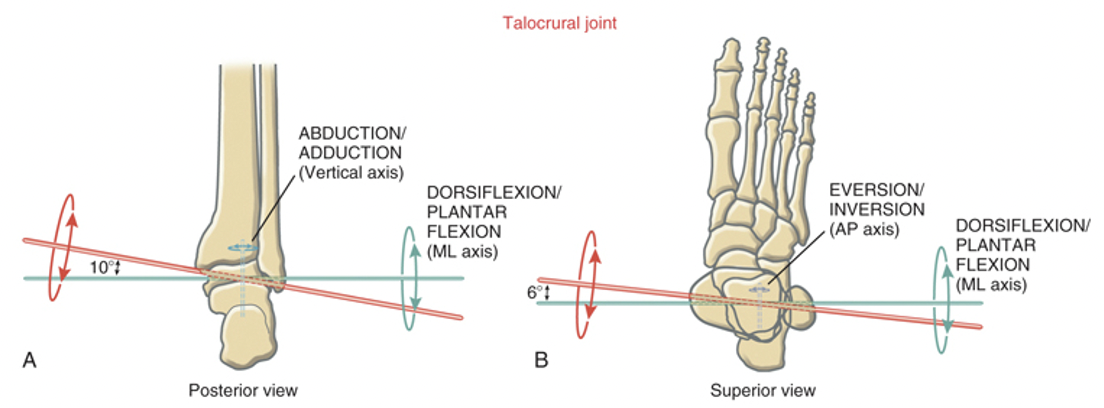
14
New cards
Normal ROM of talocrural joint
- neutral at 90 degrees
-15-25 degrees of dorsiflexion
-40-55 degrees of plantarflexion
-15-25 degrees of dorsiflexion
-40-55 degrees of plantarflexion
15
New cards
Roll and slide of talocrural joint dorsi vs plantar flexion
-dorsiflexion: talus rolls anteriorly, slides posteriorly
-plantarflexion: talus rolls posteriorly, slides anteriorly
-plantarflexion: talus rolls posteriorly, slides anteriorly
16
New cards
Bones of the subtalar joint
talus and calcaneus
17
New cards
Articulating surfaces of the subtalar joint
-posterior articular surface is larger and has it's own joint capsule
-anterior & medial surfaces are smaller and share a joint capsule
-anterior & medial surfaces are smaller and share a joint capsule
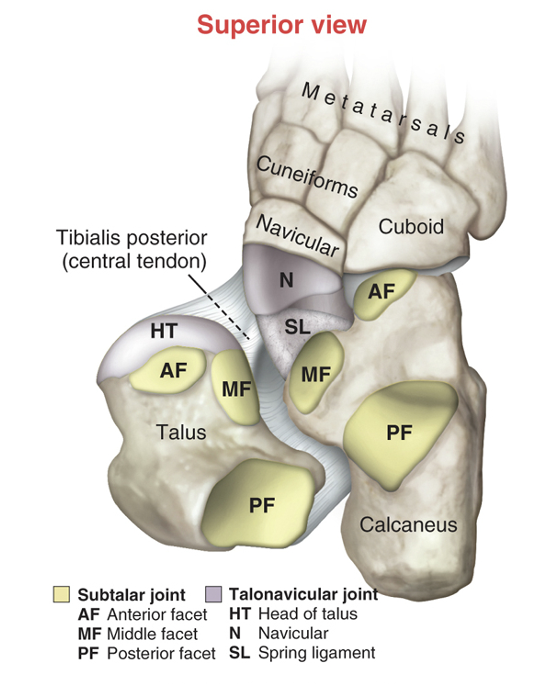
18
New cards
Ligaments that stabilize the subtalar joint
-calcaneofibular ligament stabilizes posteriorly and limits excessive inversion
-tibiocalcaneal fibers of deltoid limit excessive eversion
-talocrural ligament provides most support
-tibiocalcaneal fibers of deltoid limit excessive eversion
-talocrural ligament provides most support
19
New cards
axis of rotation of the subtalar joint
-lateral posterior heel through subtalar joint and comes out the anterior, medial, and superior direction
-~42 degrees off of horizontal plane and ~16 degrees off of sagittal plane
-~42 degrees off of horizontal plane and ~16 degrees off of sagittal plane
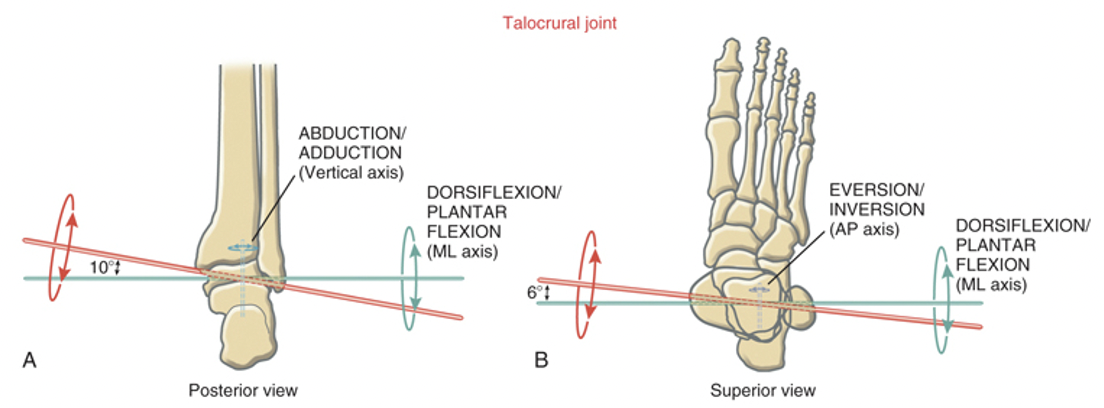
20
New cards
Movements of the subtalar joint
-inversion and eversion
-mostly accessory movements
-mostly accessory movements
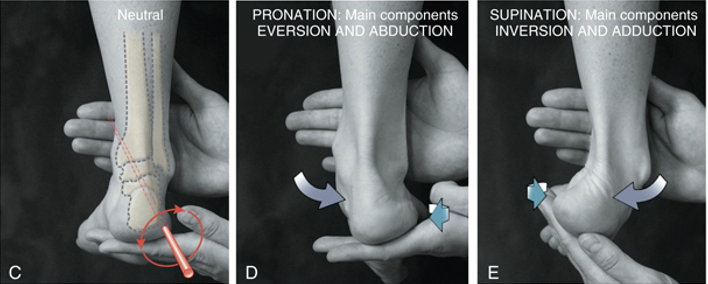
21
New cards
Bones/joints of the transverse tarsal
talonavicular joint and calcaneocuboid
22
New cards
What movements does the transverse tarsal joint allow for?
-cooperative movement of pronation/supination
-allows us to adjust to various contours of surfaces and maintain balance
-accessory movements to subtalar
-allows us to adjust to various contours of surfaces and maintain balance
-accessory movements to subtalar
23
New cards
What type of joint and types of movements occur at the talonavicular joint?
-resembles ball and socket joint --> covex talus, concave navicular
-navicular spins w/in the joint to allow for twisting, bending, etc
-navicular spins w/in the joint to allow for twisting, bending, etc
24
New cards
What ligament stabilizes the talonavicular joint?
-spring ligament
-spans from susenaculum talus to navicular
-spans from susenaculum talus to navicular
25
New cards
If spring ligament is damaged, what condition will a pt experience?
pes planus
26
New cards
Describe the movement/purpose of the calcaneocuboid joint
-Not a lot of movement at the joint
-Provides stability to the lateral aspect of the foot
-allows for translation of the propulsion/body weight onto the foot
-Provides stability to the lateral aspect of the foot
-allows for translation of the propulsion/body weight onto the foot
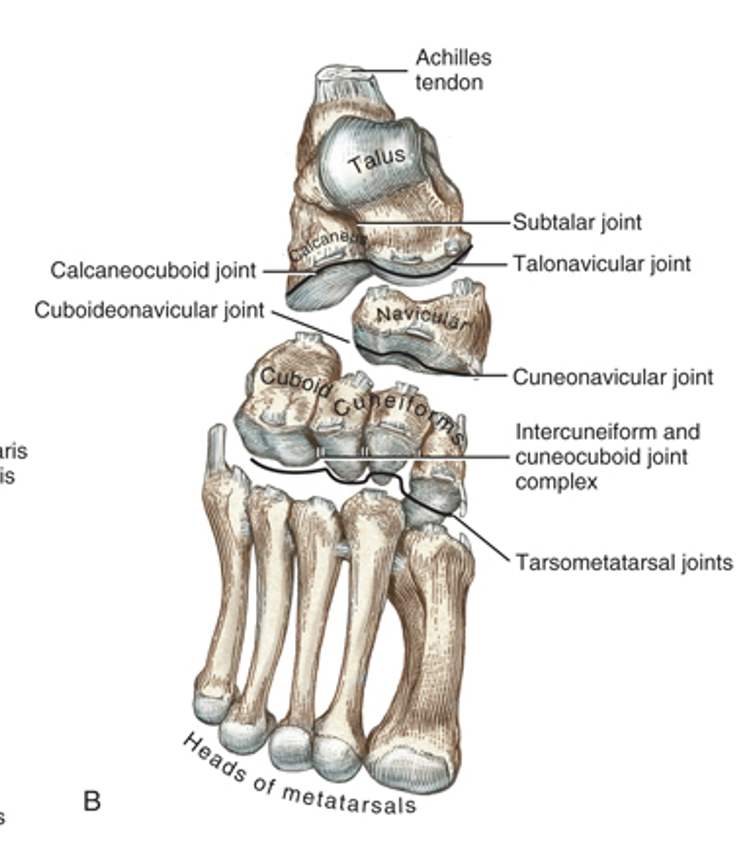
27
New cards
what are the ligaments that hold the calcaneocuboid joint together dorsally?
calcaneocuboid ligament and bifurcated ligament
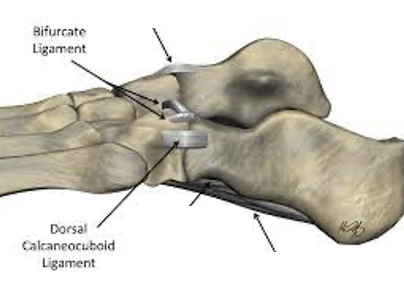
28
New cards
what are the ligaments that hold the calcaneocuboid joint together on the plantar side?
long and short plantar ligaments
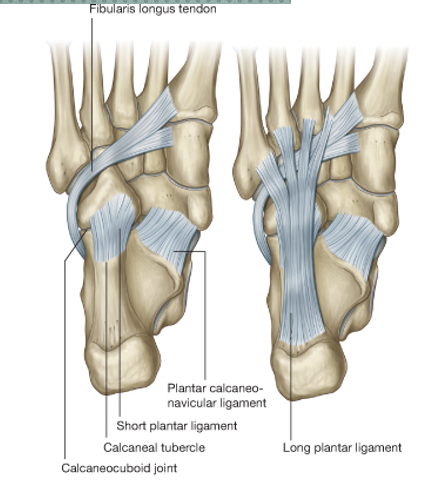
29
New cards
Where is the primary movement of the transverse tarsal?
-at the talonavicular joint, spins
-allows for pronation and supination
-allows for pronation and supination
30
New cards
What are the 2 axes of rotation of the transverse tarsal?
-longitudinal
-oblique
-oblique
31
New cards
Orientation and action of longitudinal axis of transverse tarsal
-almost in line with the anterior-posterior axis of movement
-allows for inversion and eversion
-allows for inversion and eversion

32
New cards
orientation and action of longitudinal axis of transverse tarsal
-runs vertically and medially
-facilitates motion of abduction in dorsiflexion and adduction in plantar flexion
-facilitates motion of abduction in dorsiflexion and adduction in plantar flexion
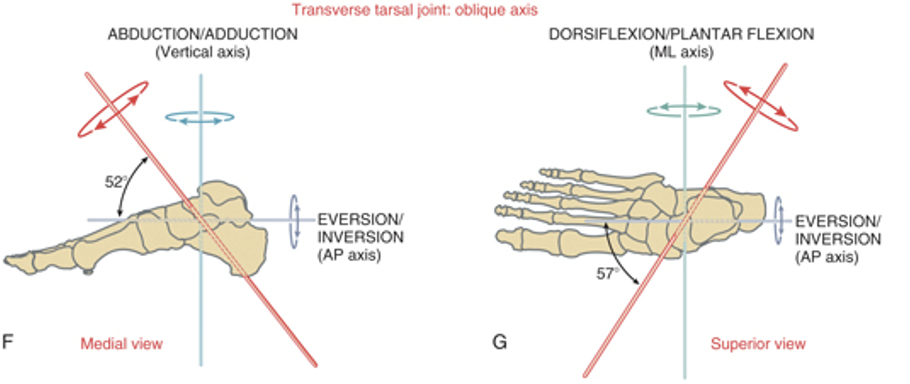
33
New cards
what are the bones/joints that are a part of the distal intertarsal joints?
-cuneonevicular joint
-cuboideonavicular
-intercuneiform
-cuneocuboid
-cuboideonavicular
-intercuneiform
-cuneocuboid
34
New cards
purpose/movement of the distal intertarsal joints?
-assist with pronation and supination by translating movement up to the forefoot
-also provides significant stability of the transverse arch
-also provides significant stability of the transverse arch
35
New cards
What is another name for the tarsometatarsal joint?
Lisfrac joint
36
New cards
What tarsal and metatarsal bones articulate with each other?
-1st metatarsal & medial cuneiform
-2nd metatarsal & intermediate cuneiform
-3rd metatarsal & lateral cuneiform
-4th and 5th metatarsal & cuboid
-2nd metatarsal & intermediate cuneiform
-3rd metatarsal & lateral cuneiform
-4th and 5th metatarsal & cuboid
37
New cards
What is a significant function of the 1st TMT joint?
-assists medial longitudinal arch
-shares/distributes the load of the body weight out through the forefoot
-shares/distributes the load of the body weight out through the forefoot
38
New cards
What amount of movement does each tarsometatarsal joint allow for?
- 2nd and 3rd: least amount of movement, most stability
-1st, 4th, and 5th: greatest mobility
-1st, 4th, and 5th: greatest mobility
39
New cards
What happens to the 1st ray/TMT joint when you are NWB and plantarflex?
1st TMT slightly everts
40
New cards
What happens to the 1st ray/TMT joint when you are NWB and dorsiflex?
1st TMT slightly inverts
41
New cards
What does the slight inversion/eversion of the TMT joint allow for?
allows for high flexibility/adaptability of the medial aspect of the foot to adapt and conform to uneven surfaces
42
New cards
What are the bones of the metatarsophalangeal joint?
-metatarsal (convex)
-proximal end of phalanx (shallow concave)
-proximal end of phalanx (shallow concave)
43
New cards
What are the ligaments of the metatarsophalangeal joint?
-collateral ligaments (run obliquely)
-plantar plate (grooved, thick ligament on plantar surface)
-transverse metatarsal ligaments
-plantar plate (grooved, thick ligament on plantar surface)
-transverse metatarsal ligaments
44
New cards
What tendon passes through the groove of the plantar plate of the 1st MTP joint?
tendon of flexor hallucis brevis
45
New cards
What is the purpose of the plantar plate?
helps for greater force distribution and propulsion
46
New cards
What is the purpose of the deep transverse metatarsal ligaments?
help build congruency b/w plantar plates, they are very important for propulsion of the foot --> important for toe off phase of our gait
47
New cards
How many DoF does the metatarsophalangeal joint have/what planes does it move in?
-2 DoF
-extension and flexion --> sagittal plane and ML axis
-abduction and adduction --> horizontal plane and vertical axis
-Passive ROM:
-toe extension: ~65 degrees
-great toe extension: ~85 degrees
- flex: 30-40 degrees
-extension and flexion --> sagittal plane and ML axis
-abduction and adduction --> horizontal plane and vertical axis
-Passive ROM:
-toe extension: ~65 degrees
-great toe extension: ~85 degrees
- flex: 30-40 degrees
48
New cards
what are the bones of the interphalangeal joint?
proximal and distal phalanges
49
New cards
what are the ligaments of the interphalangeal joint?
-collateral ligaments (run obliquely)
-plantar plate
-joint capsules
-plantar plate
-joint capsules
50
New cards
What plane and movements does the interphalangeal joint perform?
extension and flexion in the sagittal plane along the ML axis